

YOUR COMMUNITY RESOURCE FOR WHAT’S HAPPENING IN HEALTH CARE SPRING 2023 Published by Pennsylvania’s First Medical Society Medical Marijuana for Neuropathic Pain Volunteer Nurses Make a Difference at CVIM Think. Test. Treat Tuberculosis p 4 p 6 p 8 Rich McHugh p 16
OFFICERS 2023
President
David E. Bobman, MD
President Elect
Mahmoud K. Effat, MD Vice President
Richard O. Oyelewu, MD Treasurer
Winslow W. Murdoch, MD Secretary
Christina J. VandePol, MD
Editor & Immediate Past President
Bruce A. Colley, DO
Board Members
Norman M. Callahan, III, DO
Heidar K. Jahromi, MD
Mian A. Jan, MD
John P. Maher, MD
Manjula K. Naik, MD
Sean V. Ryan, MD
Francis X. Speidel, MD
Lynne A. Stilley, MBA Executive Director
Chester County Medical Society 1050 Airport Road PO Box 5344
West Chester, PA 19380-5344
Website – www.chestercms.org
Email – OurCCMS@gmail.com
Telephone – (610) 425-9190
Chester County Medicine is a publication of the Chester County Medical Society (CCMS). The Chester County Medical Society’s mission has evolved to represent and serve all physicians of Chester County and their patients in order to preserve the doctorpatient relationship, maintain safe and quality care, advance the practice of medicine and enhance the role of medicine and health care within the community, Chester County and Pennsylvania.
The opinions expressed in these pages are those of the individual authors and not necessarily those of the Chester County Medical Society. The ad material is for the information and consideration of the reader. It does not necessarily represent an endorsement or recommendation by the Chester County Medical Society.
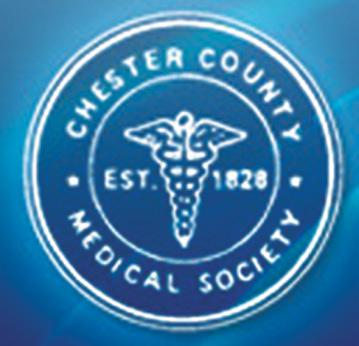
PUBLISHER: Hoffmann Publishing Group, Inc. 2669 Shillington Rd, Box #438, Reading, PA 19608 For Advertising Information & Opportunities Contact: Tracy Hoffmann 610.685.0914 x201 tracy@hoffpubs.com www.Hoffpubs.com Contents SPRING 2023 Letters to the Editor: If you would like to respond to an item you read in Chester County Medicine, or suggest additional content, please submit a message to OurCCMS@gmail.com with “Letter to the Editor” as the subject. Your message will be read and considered by the editor, and may appear in a future issue of the magazine. Cover: Soft Spring, Rich McHugh Read more in The Art of Chester County on page 16. In Every Issue 3 President’s Message 16 The Art of Chester County 4 Medical Marijuana for Neuropathic Pain 6 Think. Test. Treat Tuberculosis 8 Volunteer Nurses Make a Difference at CVIM 12 The True Value of Chester County’s Medical Reserve Corps 20 Philadelphia is Ready to Overcome Gun Violence, Our Great American Epidemic 24 GLP-1 Agonists: Something So Good for Patients Just Shouldn’t Be So Hard to Get 26 The Domino Effect of Physician Advocacy 28 Convergence of Two Commonwealth Court Rulings 30 National Alcohol Awareness Month 31 Chat GPT-4 Writes Poetry on the Experience of Physician Burnout Features
David E. Bobman, MD President, Chester County Medical Society
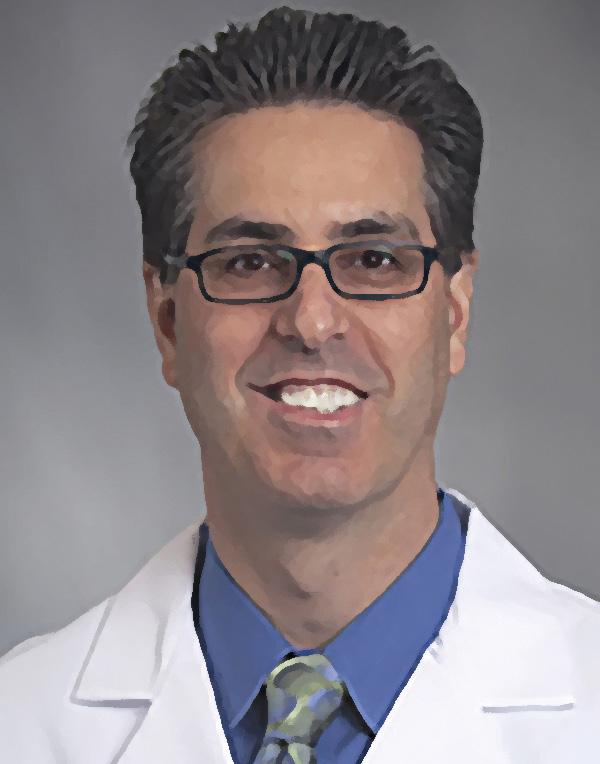
PRESIDENT’S MESSAGE
Spring 2023
BY DAVID E. BOBMAN, MD PRESIDENT OF CHESTER COUNTY MEDICAL SOCIETY

Spring is here! Trees are blossoming, flowers are blooming, birds are chirping. The days are longer and the weather warmer. This gives me a cheerful and optimistic feeling. Our Medical Society Board has been working hard on many issues which also creates optimism for the future.
One of the issues we have been grappling with is introspection; trying to make sure that we continue to have our finger on the pulse of our members and remaining relevant to their needs. To this end, we emailed a brief questionnaire to get your viewpoints. First, I would like to thank the numerous member and non-member physicians in the community for taking the time to respond. While all responses have not yet been tabulated, I am seeing some common themes. One of the more common issues includes the stress of working in today’s environment – too many hurdles to get testing and treatment effected, time consuming EMR programs, and wasted time attending to peer-to-peer interactions. This not only limits the time we can spend with patients, but also the free time we have available to spend with family and friends. Difficulties in hiring physicians, physician extenders and staff, putting further stress on daily practice further exacerbate this.
The issue of venue shopping in malpractice cases is also a significant cause of concern among our responses, bringing flashbacks of the difficulties encountered about 20 years ago.
Scope of practice by physician extenders was yet another common concern with many physicians raising concerns over a drop in quality of care delivered to patients. This is particularly a concern given the push for extenders being allowed to practice without physician oversight.
Several other issues were raised as well. While these are all very important issues, they have many aspects, making them too complex to cover here. Suffice it to say, your concerns are well taken. The Chester County Medical Society and the Pennsylvania Medical Society are already in the process of addressing these issues, though some will require a rather Herculean effort. We have already established or are in the process of establishing working groups to address these very issues. I encourage anyone interested to join our efforts.
While progress moves slowly, I am optimistic that we can make a difference!
Fond Regards,
David
on your mind? Help us to learn more about emergent trends affecting your work! Write to us at: OurCCMS@gmail.com www. CHESTERCMS .org
What’s
SPRING 2023 | CHESTER COUNTY Medicine 3
Medical Marijuana for Neuropathic Pain
 BY DAVID J. GOLDSTEIN, PHD, FCP* PROFESSOR OF CLINICAL PHARMACOLOGY PHILADELPHIA COLLEGE OF OSTEOPATHIC MEDICINE
BY DAVID J. GOLDSTEIN, PHD, FCP* PROFESSOR OF CLINICAL PHARMACOLOGY PHILADELPHIA COLLEGE OF OSTEOPATHIC MEDICINE
Marijuana for pain? Who does that? Actually, many Americans do across all ages even into the geriatric range.
Opioids have been among the most widely used drugs to relieve acute and chronic pain but there are issues with long-term use. In 2022, the Departments of Veterans Affairs and of Defense issued their Clinical Practice Guideline for pain management. As stated therein, “The guideline development group does not recommend use of opioid analgesics in the daily management of chronic pain. The benefits that opioids can provide are small and are outweighed by the risks to the patient.”
Is marijuana a good substitute? In my opinion, it is. However, what is missing are well-designed clinical studies to provide greater understanding of this beneficial effect.
As a medical scientist, I have been conducting clinical research for decades to improve analgesia in patients with cancer and/or neuropathic pain as well as in the immediate post-op period of those recovering from surgery. Currently, I have two preliminary (pilot) studies in progress.
One of my current investigations is at the Philadelphia College of Osteopathic Medicine (PCOM). Along with my clinical colleague, Katherine Galluzzi, DO, I administer THC to those presenting with chronic neuropathic pain. Our patients have diverse etiologies, e.g., multiple sclerosis, diabetic peripheral neuropathy, temporomandibular joint disorder, but all have suffered from nerve pain for at least two months. The insurance classification for chronic pain coverage is three months but as a medical scientist I can start treating patients earlier. Funding is from the PCOM Division of Research, and there is no cost to any patient.
THC is the main psychoactive ingredient in marijuana but also provides analgesia. We use Marinol-CIII, an FDA-approved drug officially sanctioned only for treating nausea and vomiting from cancer chemotherapy, and as an appetite stimulant in those suffering from a lack of appetite such that their lives are in danger, e.g., AIDS patients.
The use of THC for analgesia is not banned in the USA but is considered an ‘Off’-Label’ use, that is, one that does not have FDA authorization. To receive approval, I – as the Principal Investigator – submitted our study for evaluation by the PCOM Institutional Review Committee (IRB). Permission was granted, and the project began.
We carefully evaluate all patients who wish to participate since entrance is not automatic. Some of the criteria for admission are age 18 to 75 years old, and having neuropathic pain for at least two months. Participation is not permitted for several reasons including patients with cardiovascular or liver problems, epilepsy, depression or substance use disorders.
This is a seven-week study. Patients are seen every week. For the first two, patients complete a pain diary three times a day, using an 11-point scale from ‘0’ [ “I have no pain”] to ‘10’ [ “This is the worst pain I ever had”]. They also list how many of their usual pain medications they take each day. If there are no problems in this important record-keeping aspect, they are given, in Week 3, capsules containing 5 mg of THC; one is to be taken at night at lights-out time. Patients continue to be seen each week, and decide at that time if they wish to go up to the next doses, i.e., increasing by 5 mg up to 20 mg in Week 6, the last week.
I need to emphasize that this is a ‘pilot’ study; in clinical research; this means it is a starter project. This investigation involves a limited number of patients who will be given THC in gradually increasing doses to observe if there are any reductions in pain, and
4 CHESTER COUNTY Medicine | SPRING 2023 www. CHESTERCMS .org
PentaHealth Colonial Family Practice

217 Reeceville Road, Suite A, Coatesville, PA 19320
610-269-9448
PentaHealth Primary Care Downingtown
142 Wallace Avenue, Suite 201, Downingtown, PA 19335
610-873-2700
PentaHealth Family Practice West Chester
1240 Wrights Lane, West Chester, PA 19380
610-431-1210
PentaHealth Family Practice Exton
770 West Lincoln Highway, Exton, PA 19341
610-269-1372
PentaHealth Family Practice Newtown Square
4667 West Chester Pike, Newtown Square, PA 19073
610-356-7870
PentaHealth at Mt. Airy Family Practice
760 Carpenter Lane, Philadelphia, PA 19119
215-848-6880
what, if any, side effects occur. If the early results are promising from a pilot study, then researchers run a larger study that has at least two groups, one of which is a placebo. It is always important to do this in larger studies because sometimes patients experience true benefit from placebo that is actually from their own internal desires. They have a strong expectation that the product will work – and, for them, it does. Therefore, the placebo effect is real, and is important to study along with the active drug at some later point with larger numbers of patients.
Okay, so what have Dr. Galluzzi and I found in the seven patients that we treated? The average pain score in the first two weeks with no THC was 4.9 but after the four weeks of taking THC (going from 5 mg to 20 mg at ‘lights-out’ time), the score dropped to 2.7. It is a real clinical effect whenever the average score drops by at least 2 points. However, subjects have reported not only less pain – which is the most important – but other benefits as well. My patients always ask about weight gain having heard that marijuana increases appetite (a/k/a/ the ‘munchies’). Good news! While two did have a slight increase, the other five lost weight! Why? Well, they reported being able to sleep better so they had less stress and did not seek comfort food (e.g., ice cream) as often. With less pain they were able to be more active, e.g., greater distances in walking their dogs.
PentaHealth Village Family Medicine at Lionville
93 West Devon Drive, Suite 100, Exton, PA 19341 610-321-0200
PentaHealth Internal Medicine West Chester
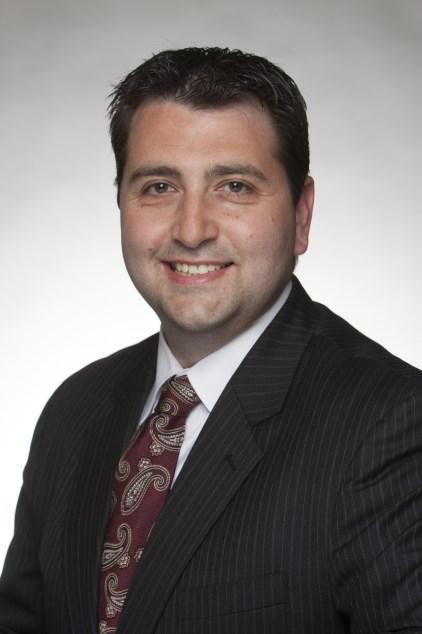

520 Maple Avenue, Suite 4, West Chester, PA 19380
610-430-8200
PentaHealth Endocrinology
795 East Marshall Street, Suite G2, West Chester, PA 19380
610 -431-7929
There were some side effects. We had to remove two patients from the study because they were experiencing dizziness; at night, when going to the bathroom, this serious side effect could cause a fall with a severe outcome like a bone fracture.
As mentioned, this is a limited investigation but recruitment is still occurring. If any person with chronic neuropathic pain for a duration of at least two months is interested in more information, please contact me: fredg@pcom.edu.
I am also starting another pilot study on the pain-relieving benefit of a combination of THC plus cannabidiol (CBD) for chronic pain which will described in a subsequent article.
* Fellow in Clinical Pharmacology
1. Sandbrink F et al. The Use of Opioids in the Management of Chronic Pain: Synopsis of the 2022 Updated U.S. Department of Veterans Affairs and U.S. Department of Defense Clinical Practice Guideline Ann Intern Med. doi:10.7326/M22-2917
SPRING 2023 | CHESTER COUNTY Medicine 5 www. CHESTERCMS .org
Dr. John Khalifa PentaHealth President
Dr. Charles Catania
PentaHealth Medical Director
THINK. TEST. TREAT TUBERCULOSIS
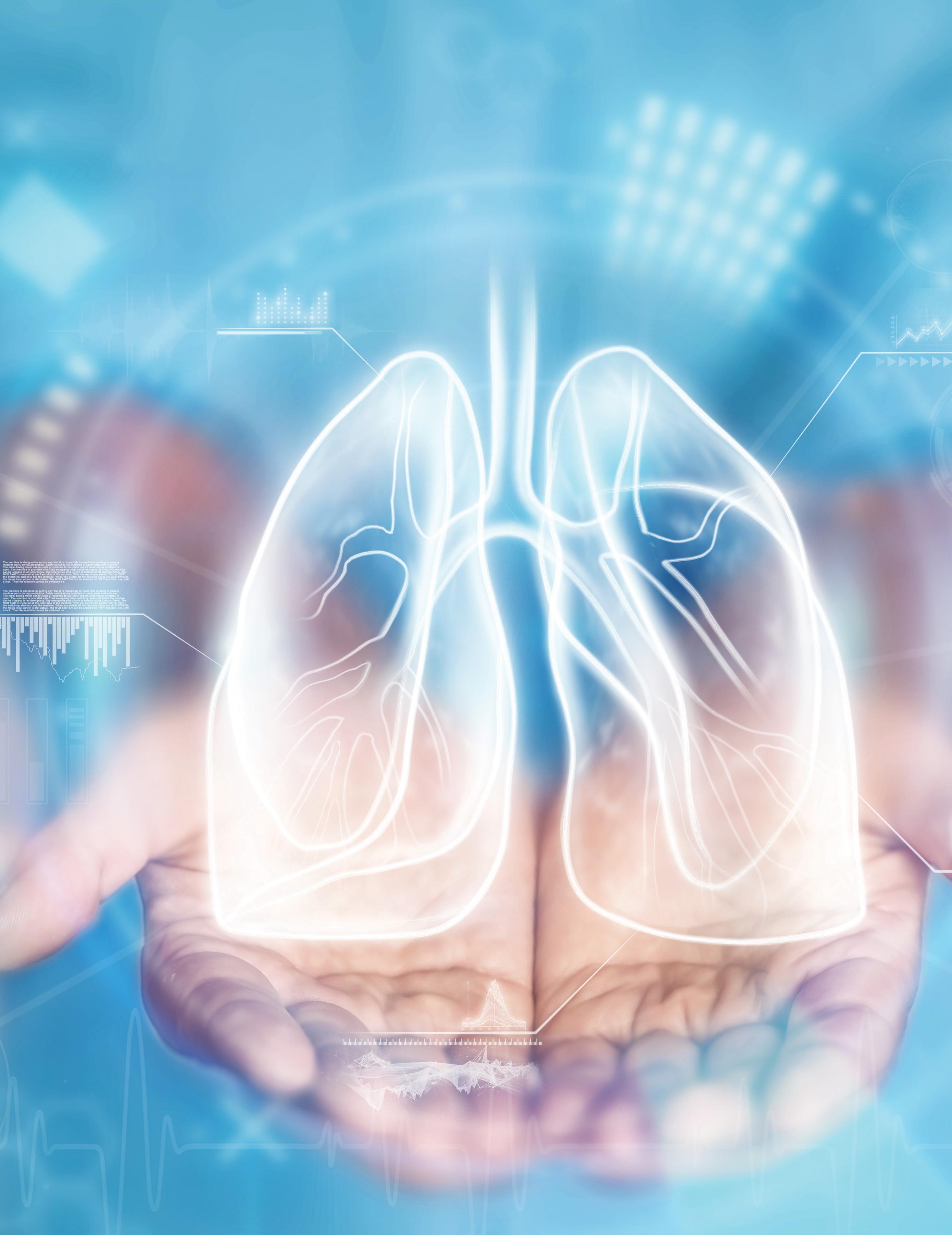
6 CHESTER COUNTY Medicine | SPRING 2023 www. CHESTERCMS .org
Tuberculosis has been infecting and killing man since the dawn of civilization. Western countries, thanks to concerted Public Health efforts to eliminate TB, have greatly decreased its incidence. The U.S. incidence rate of TB disease, formally known as Active TB, was 52.6 cases per 100,000 population in 1953. The U.S. incidence in 2021, per the current CDC release of “Reported Tuberculosis in the United States, 2021,” is 2.4 per 100,000 population. The Public Health goal of one case per one million population is still a work in progress with the COVID pandemic having slowed the steady progress made in recent years.
In an ever-shrinking world, and in a county that welcomes a significant number of immigrants from countries with high TB incidence, it is useful to review worldwide and State statistics. In 2021, there were 10.6 million cases of TB disease worldwide, with 1.6 million deaths. TB was the 13th leading cause of death worldwide, second only to COVID in infectious causes. Pennsylvania reported 166 cases of TB disease in 2021. The greater Philadelphia metropolitan area, who reports separately, recorded another 160 cases. Non-U.S.-born Pennsylvanian cases were in line with national numbers at 73.5%. Persons 65 and older comprised 30.1% of PA cases. 47% of PA cases were of Asian descent and 10.2% were Hispanic. Healthcare workers made up 8.0% of cases in Pennsylvania.
Activation of Latent TB Infection (LTBI) is responsible for a large percentage of TB disease. It is estimated that up to one third of the world population is infected with TB, with an estimated 13 million infected in the U.S. Activation of LTBI to TB disease occurs in up to 10% of infected but immunocompetent individuals over the course of their lifetime, and increases up to 30% of those infected with concurrent Diabetes. In those living with HIV, the activation rate increases even further to 7-10% per year of their lifetime. With an immature immune system, children 4 years of age and younger have a high risk of TB Infection progressing to TB disease.
THINK TB.
Thinking about the possibility of TB Infection leads to identifying those at risk for LTBI and progression to TB disease. LTBI presents with no symptoms, is not contagious, and is easy to overlook unless we are thinking about TB. It is not recommended to test individuals who have no risk factors or symptoms as it will lead to false positive tests and unnecessary treatment. However, birth, travel, or residence in a country with increased TB prevalence should raise suspicion for LTBI. The only countries with low prevalence of TB are the USA, Canada, Australia, New Zealand, and western and northern Europe. People with HIV, cancer, or any other immune compromise or suppression such as those with
a renal transplant should be tested. Evaluation for TB should be performed prior to a patient receiving a biologic agent for treatment of conditions like Rheumatoid Arthritis or Psoriasis. Patients, especially young children, who have close contact to a person with TB disease, and those with suspicious CXR findings, should be tested. Also consider testing patients who have a history of residence in a high risk congregate setting, such as prison or a homeless shelter. High risk healthcare workers should also be considered for testing. Diabetes is the most reported risk factor in 2021, found in 23.9% of TB disease cases in the U.S.
TEST FOR TB.

Testing for TB can be performed by a blood test, commonly referred to as IGRA (interferon gamma releasing assay) or by the Tuberculin Skin Test (TST). There has been universal agreement that the IGRA is the preferred test in the U.S. One of the reasons for the IGRA preference is that unlike the TST, there is no false positive reaction to the BCG vaccination which is performed shortly after birth in many high prevalence countries. The IGRA was previously recommended for patients five years of age and older, but today we use it in patients one year and older. Neither the TST nor the IGRA test can distinguish LTBI from TB disease; therefore, all patients who test positive should be evaluated for TB disease versus LTBI. TB disease is evaluated by detailed history, physical examination and Chest X-Ray. Patients who have a positive IGRA should have a Chest X-Ray and be referred to the Health Department for diagnostic workup and treatment.
TREAT LTBI.
Treating every person with LTBI will significantly lower the cases of TB disease. It is no longer standard of care to assume a person with LTBI will not go on to activation of TB disease. A young healthy person may develop diabetes, be diagnosed with cancer, contract HIV, or simply require a biologic agent for another disease process. Regimens for LTBI have been shortened to 3-4 months and are generally well tolerated. Daily LTBI medication regimens do not require direct observation by the public health department. Shorter course, well tolerated therapy has reduced the pill burden on the patient and improved compliance. By preventing activation of LTBI to TB Disease, we have a large health care cost savings, and significantly reduced morbidity and mortality.
When I think of Chester County, I think of rolling green fields with horses, lush farmland, and quaint towns. I also think of TB, especially with so many newcomers arriving to jump on the ladder of economic success. Think. Test. Treat LTBI will make our county healthier for everyone.
SPRING 2023 | CHESTER COUNTY Medicine 7 www. CHESTERCMS .org


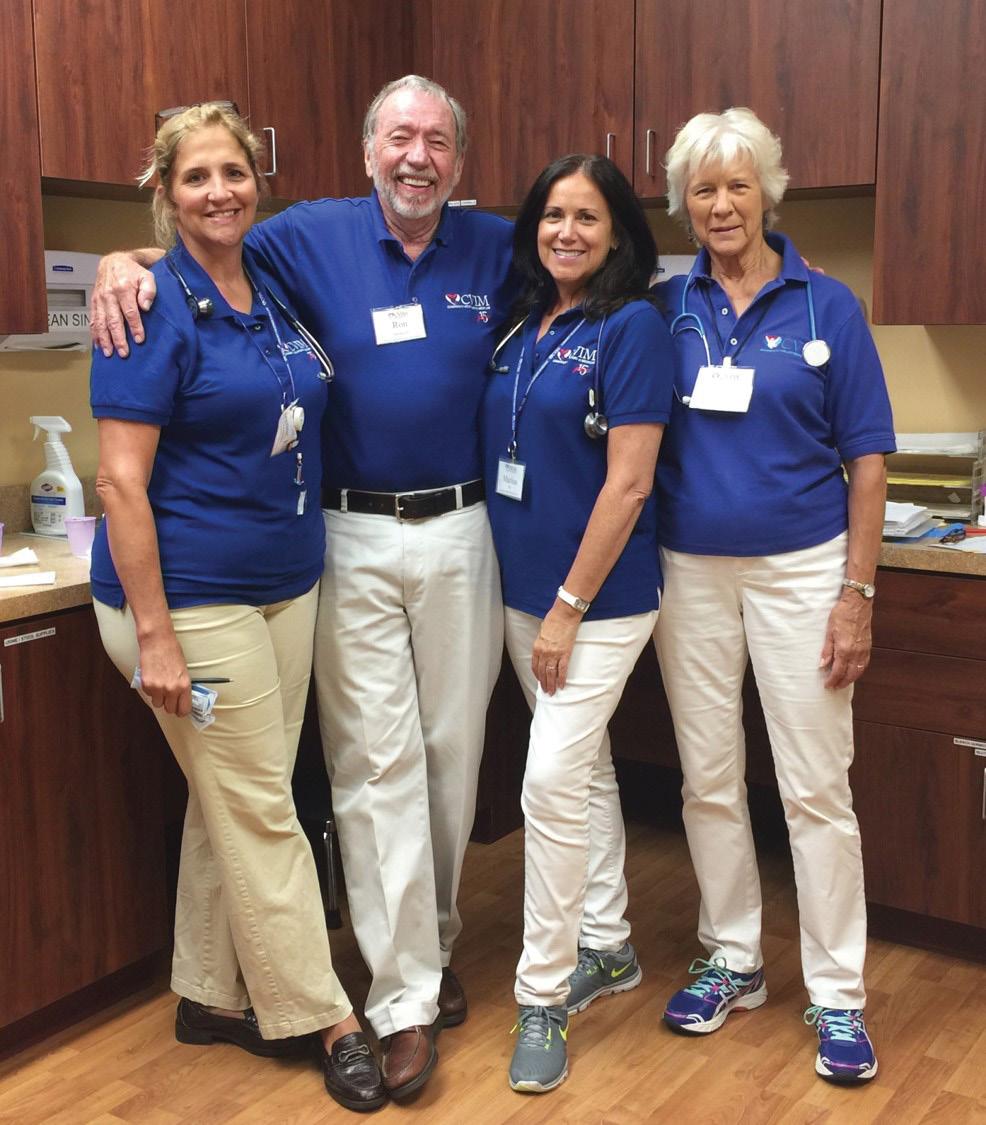
8 CHESTER COUNTY Medicine | SPRING 2023 www. CHESTERCMS .org
Volunteer Nurses Make a Difference at CVIM
BY ARIELLA JOLLY, DNP, FNP-BC, SENIOR DIRECTOR, NURSING AND WOMEN’S HEALTH


Anne took several years off from her nursing career to raise her family and care for her ailing mother. She was unsure if she’d ever return to nursing, until a friend told her about CVIM. She decided to check it out, and upon visiting was inspired to sign on as a volunteer.
That was more than 13 years ago. Now, she considers herself “lucky and blessed” to have spent over a decade volunteering regularly for CVIM. Like so many other CVIM volunteers, she underscores the best part of the job: “The patients give me more than I give them,” she says. She describes the patients she sees while working at CVIM as “so strong, and such phenomenal, good, working people.”
As a healthcare center serving low-income, uninsured workers and their families, Community Volunteers in Medicine relies on the time and expertise of a generous, experienced army of volunteers to meet the needs of its large and growing patient population.
Offering everything from primary medical care to specialists, dental care, behavioral health, and prescription medicines, CVIM is the healthcare home for many people throughout Chester County and beyond. CVIM’s patients are the working core of the local economy: restaurant staff, bus drivers, agricultural and landscape workers, and others who work at small businesses that don’t provide health insurance.
The overwhelming majority of CVIM’s health care providers work on a volunteer basis; in fact, in the last fiscal year, CVIM’s 329 volunteers logged over 38,000 volunteer hours serving 4,263 patients.
The backbone of this fleet is our volunteer nurses. While volunteer nurses come to CVIM at all stages in their career, many have recently retired from positions at local hospitals, healthcare centers, doctors’ offices, or home healthcare organizations. Others left paid employment to raise children or care for family members, or may work part-time, and are now in a position to be able to give back to their community. Volunteering at CVIM allows them to use their skills with a flexible schedule, often with opportunities to try something new or explore different interests. CVIM allows them to stay involved with the profession they love, in a warm, welcoming environment.
When discussing how she accommodates the scheduling needs of her volunteers, CVIM’s Director of Clinical Support Services, Judy Atticks, RN, emphasizes the flexibility she offers to volunteer nurses. “I try very hard to make sure they know they are able to do what they feel is in their hearts,” she explains. Some nurses remain doing the type of work they did when previously employed, while others may make a leap from, for example, gynecological care to primary care. Many find themselves enjoying the ability to augment their expertise with new experiences they didn’t have at other times in their careers.
continued on next page >
SPRING 2023 | CHESTER COUNTY Medicine 9 www. CHESTERCMS .org
CVIM - Senior Director, Nursing and Women’s Health
continued from page 9
With thirty medical specialties offered at CVIM, clinicians find many options to choose from and no shortage of work to do. In a given day, CVIM’s nurses may find themselves administering medications or immunizations, performing hearing tests or pointof-care testing, or assisting with office procedures for both primary and specialty care.
More importantly, without the time limitations imposed by insurance billing requirements, they build strong relationships with patients over the years. It is not an uncommon sight to see a patient stopped in the hall by a nurse or two who come running over to offer them a hug and ask how they have been doing.
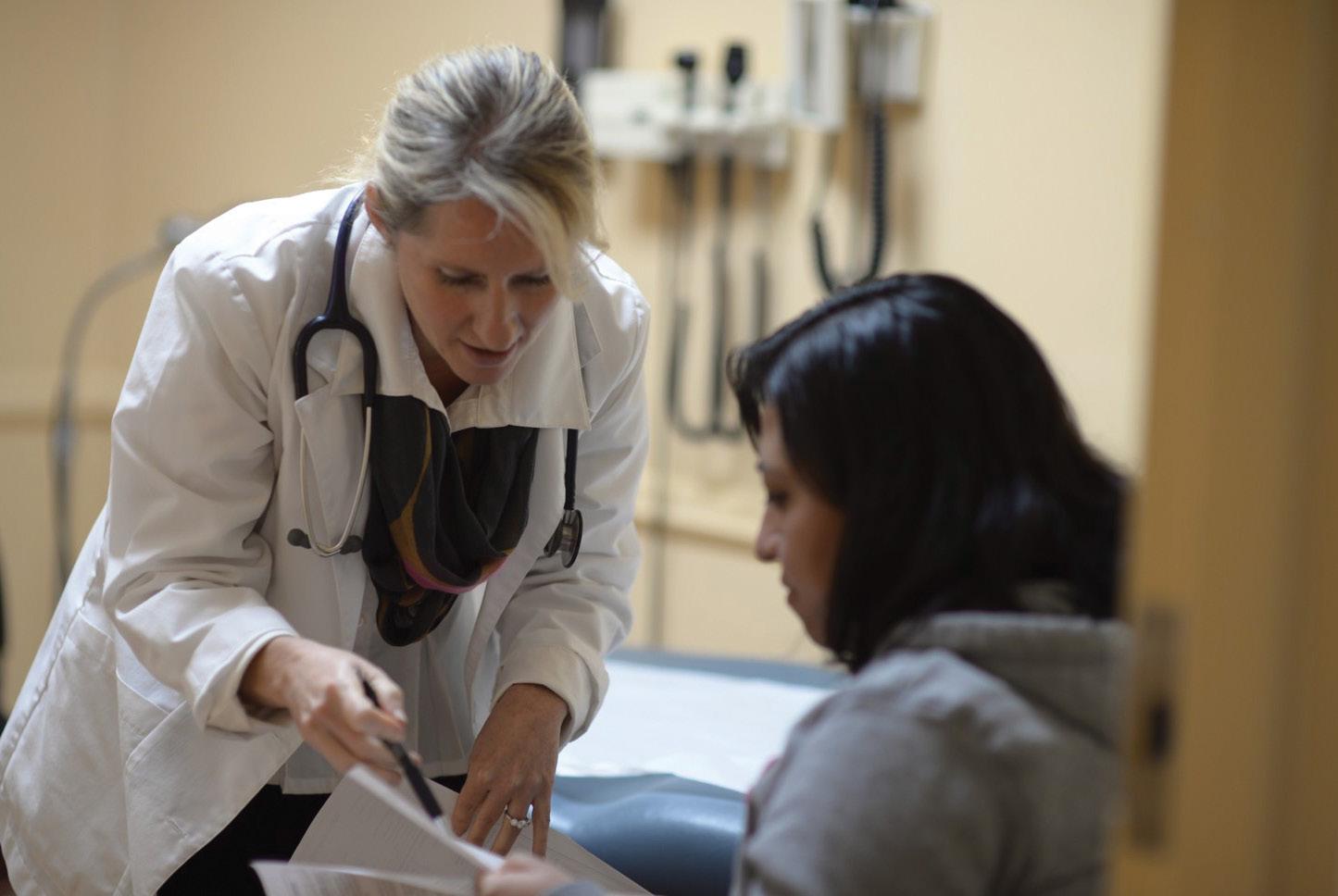
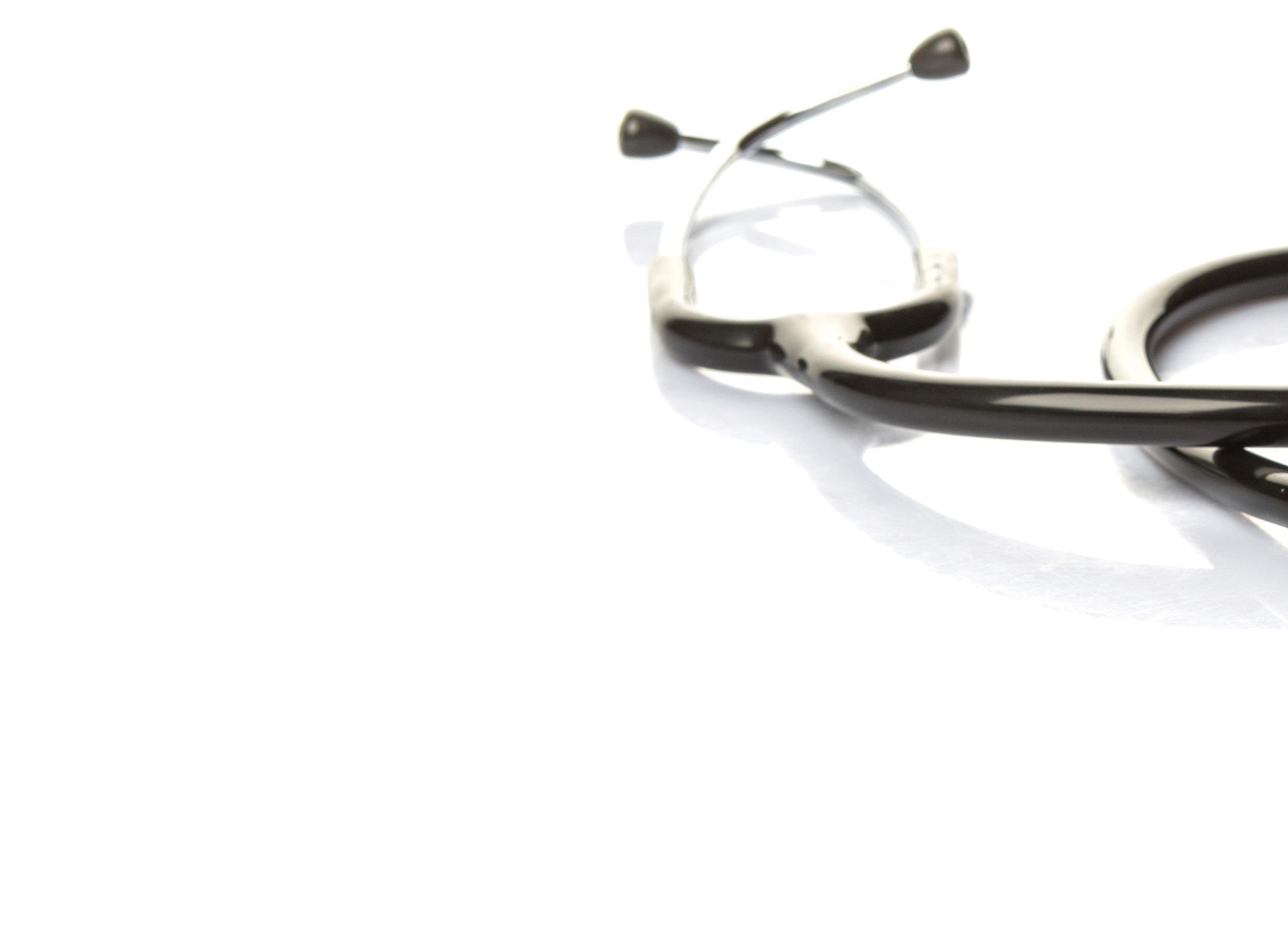
There are also opportunities for nurses to be involved in larger awareness and educational programs, such as the annual Diabetes Expo, immunization drives, or Cervical Health Awareness Month events.
It’s not just the patients who benefit from the warm, caring atmosphere at CVIM. Judy points out that many come to volunteer at CVIM after experiencing some sort of personal life transition or loss. She encourages a space where nurses can talk to each other and turn to one another for support if they find it
helpful. “Some of the nurses become like family, while others are more private,” she says, noting that the personal and emotional well-being of nursing volunteers is of paramount importance. “Sometimes, my role is to get to know the volunteer nurses and their families; and sometimes, my mission is to make sure everybody knows I care.”
CVIM volunteers, from nurses to doctors to behavioral health experts, often speak of the warm, collaborative atmosphere at CVIM, which many note is harder to find in healthcare in recent years. Indeed, volunteers often describe the CVIM culture as being “why I got into health care.” The ability to spend time with patients, build relationships, and in turn receive overwhelming appreciation is a constant refrain when speaking to those who volunteer here.
CVIM’s Medical Director, Dr. Janet Jacapraro, underscores the importance of volunteer nurses to CVIM’s mission. “Nurses are critical to the function of our medical team. They administer medicines and vaccines. They complete in-house testing and provide educational materials. They alert the providers to patient concerns and overdue screenings. But by far, what I value most
10 CHESTER COUNTY Medicine | SPRING 2023 www. CHESTERCMS .org
about the nurses I work with at CVIM is how they are able to set the stage for a positive medical visit with each individual patient. Before I even enter the exam room, my patient has been put at ease by a nurse’s caring touch and warm smile.”


A nursing orientation is provided, and CVIM offers ongoing educational opportunities and workshops for its clinical care staff on everything from Tuberculosis, to HPV to whatever else is new or changing in the medical field. While Spanish-speaking clinicians are in high demand, CVIM has volunteer interpreters, so it is not necessary that clinical volunteers speak a second language. Masks are being worn in the health care center, and COVID vaccination is required.
If you are interested in learning more about becoming a volunteer at CVIM, please contact Judy Atticks at jatticks@cvim.org, or 610.836.5990 x.112.
SPRING 2023 | CHESTER COUNTY Medicine 11 www. CHESTERCMS .org
The True Value of Chester County’s Medical Reserve Corps
BY COUNTY COMMISSIONER MARIAN MOSKOWITZ
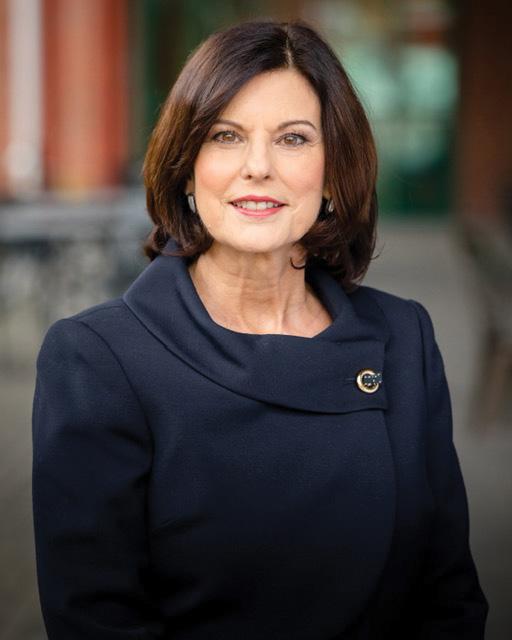
Last month, the Chester County Commissioners proclaimed April as National Volunteer Month, recognizing the tens of thousands of individuals and organizations that give freely of their time and talents to help others. Across Chester County government, volunteers support County departments, with an estimated savings to taxpayers of around $1 million a year. One such volunteer organization is the Chester County Medical Reserve Corps (MRC). Here, Chester County Commissioners’ Chair Marian Moskowitz notes the beginnings and growth of the Chester County MRC and acknowledges the incredible contributions that its medical and non-medical members make for our community.
The events that occurred on September 11, 2001, led to many changes in the way that communities across the nation – and the world – responded to tragedies, whether natural or man-made. And the response by healthcare workers in the days that followed 9/11 led to medical and emergency response personnel flooding into New York and Washington to assist with rescue and recovery efforts. In fact, so many people poured into these cities that first responders did not know where or how to organize the volunteers. This is what catalyzed the formation of our nation’s Medical Reserve Corps (MRC).

After 9/11, when it became clear that a pre-credentialed and pre-trained volunteer force was not only beneficial, but necessary to support the nation, the MRC was created, bringing together volunteers, both medical and non-medical, committed to improving the health, safety, and resiliency of their communities.
Today, the MRC network has more than 300,000 volunteers in roughly 800 community-based units throughout the United States. MRC units organize local volunteers who want to donate their time and expertise to prepare for and respond to emergencies and to support ongoing preparedness initiatives. Nationally, the MRC is housed under the Readiness Division in the Office of Emergency Management and Medical Operations, and the Assistant Secretary for Preparedness and Response under the U.S. Department of Health and Human Services.
12 CHESTER COUNTY Medicine | SPRING 2023 www. CHESTERCMS .org
Providing crucial support for the health, safety, and resiliency of Chester County.
Chester County’s MRC Volunteers
Major local emergencies can overwhelm the capability of first responders, especially during the first 12 to 72 hours. Having citizens who are prepared to take care of themselves, their families, and others during times of crisis allow first responders to focus their efforts on the most critical, lifethreatening situations. An organized, credentialed, and trained MRC means that volunteers can effectively respond to local public health emergencies.
It should come as no surprise that Chester County recognized the great value of establishing an MRC 15 years ago. Leading up to 2008, the Chester County Health Department formally noted the increased need to augment community readiness. More funding became available from the federal government to support the creation of countylevel MRCs across the country, and Chester County took advantage of that. Since its inception, the MRC in Chester County has been supported by the Health Department’s Public Health and Emergency Preparedness team.
In the few years after becoming established, the Chester County MRC had 39 registered volunteers. Within 10 years, the membership number grew to 10 times that. And in those first 10 years, notable events and training exercises were supported by the Chester County MRC including Hurricane Sandy response, the February 2014 major ice storm, the World Meeting of Families Papal Visit, a Philadelphia Airport Crash Simulation Drill, and mass care and evacuation exercises. The efforts made by our county MRC volunteers during every one of these events and exercises were extremely valuable.
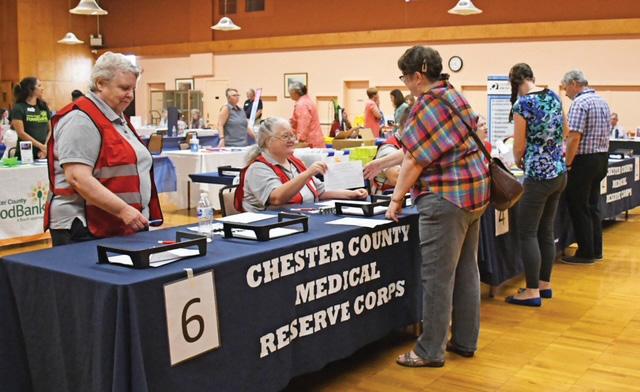
Chester County Medical Reserve Corps Eligibility


Individuals 18 years and older can register to become an MRC volunteer. Chester County’s MRC volunteers are matched with emergency roles that reflect their skills and certifications –medical doctors, nurses, dentists, mental health professionals, accountants, and professors. Some of the volunteers are retired, but many have day jobs.
Being an MRC volunteer comes with many benefits beyond the satisfaction of helping someone. Chester County provides MRC volunteers with learning opportunities and skills development, priority vaccinations and medication during emergencies, free training, networking, hands-on drills and exercises, and disaster and emergency response opportunities.
Anyone can join the MRC, and new volunteers are welcome year-round. To learn more about Chester County’s MRC, visit www.chesco.org/MRC. continued on next page >
SPRING 2023 | CHESTER COUNTY Medicine 13 www. CHESTERCMS .org
The True Value of Chester County’s Medical Reserve Corps continued from page 13
By 2020, our MRC volunteer numbers increased tremendously, and they were, of course, ready to go, and instrumental in Chester County’s public health response to the pandemic. When COVID-19 shut down Chester County in March 2020, MRC volunteers served as call-takers in Chester County’s Public Health Call Center. They assisted at COVID-19 testing sites and vaccine clinics. They provided onsite support at the Food Bank to continue Food Bank operations for the growing number of food insecure residents. They called individuals who tested positive for COVID-19 to provide guidance in mitigating the spread of the virus. In total, MRC volunteers in Chester County spent nearly 15,000 volunteer hours over 2020 and 2021!
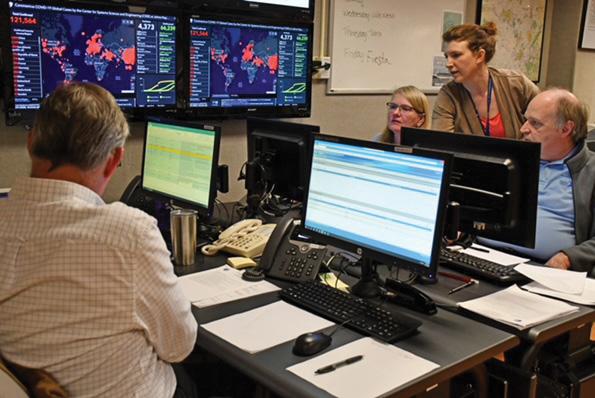
Chester County’s Public Health Director Jeanne Franklin lauds the efforts of our MRC members, now increased to more than 1,300 medical and non-medical volunteers. According to Jeanne, our County’s Health Department could not have reached so many people during the COVID-19 response if it was not for our MRC volunteers. I certainly agree, and I know that we could not have extended a helping hand to Delaware County during that time, were it not for our MRC volunteers.
Beyond the pandemic, MRC volunteers also engage in non-emergency services, including public awareness campaigns, first aid booths, vaccination clinics, localized disease outbreaks, recruitment events, and public health education events. In 2022, volunteers deployed to two major Health Department initiatives: the Annual Potassium Iodide (KI) Distribution Event and the 2022 Fall Vaccination Campaign (for COVID-19 and flu vaccinations).
To ensure Chester County’s MRC is empowered to respond effectively, safely, and confidently, volunteers participate in year-round trainings. Over the last year, MRC volunteers have completed Stop the Bleed, Active Threat Management, Radiological Awareness, Psychological First Aid, and Naloxone trainings, among others.
While you can’t really put a monetary value on the time, talent, and voice of Chester County’s MRC volunteers, cost savings can be approximated in the delivery of programs supported by them. Volunteer hours spent on training, exercises and deployment equate to more than $215,000 over the period between 2020 and 2022.
14 CHESTER COUNTY Medicine | SPRING 2023 www. CHESTERCMS .org
IT’S YOUR #1 DEFENSE AGAINST ONE OF THE MOST LETHAL CANCERS.
It’s fast. It’s painless. Most insurance will cover it for patients 45 or older. And it could save their lives.
Colon cancer can be deadly when it’s not caught early. But it can be completely eradicated through early detection by colonoscopy. Now, thanks to a GI Genius™-enabled colonoscopy, technology aided by artificial intelligence, doctors at Main Line Gastroenterology Associates can diagnose colon cancer with unprecedented accuracy.

DON’T PUT IT OFF. REFER YOUR PATIENTS FOR A COLONOSCOPY TODAY.
COLONOSCOPY CANCER
It could be the choice of your patient’s life.
We are truly fortunate to have such a large group of dedicated, knowledgeable, and highly trained volunteers registered with the Chester County MRC who consistently commit to serving with the Health Department, for all county residents and businesses. On behalf of everyone in Chester County, I thank all our MRC volunteers for being ready whenever needed to care for Chester County residents, and for fulfilling the MRC purpose of ensuring the health, safety, and resiliency of our Chester County community.
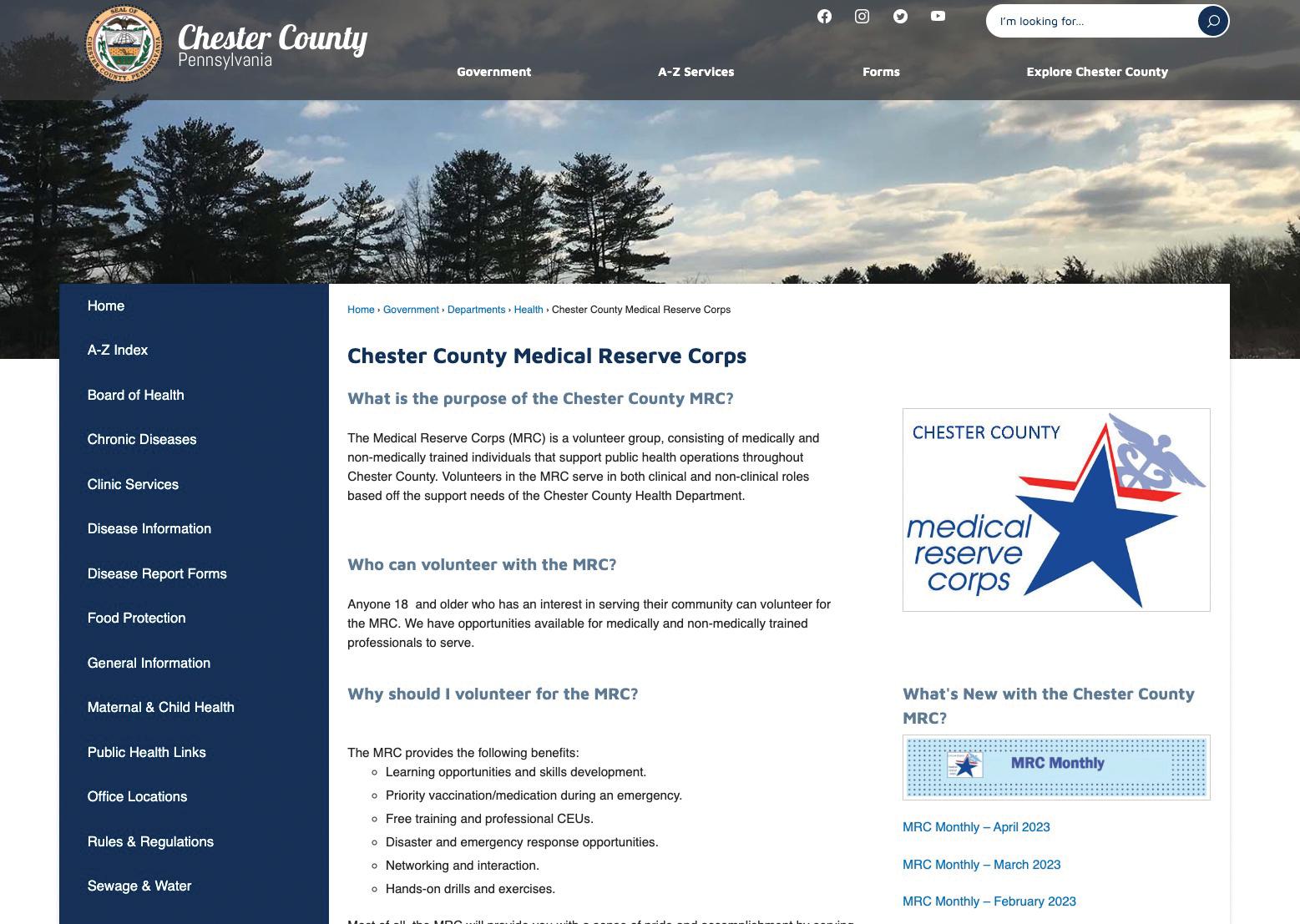
Marian Moskowitz has served as a Chester County Commissioner since January 2020, and currently serves as Chair of the Board.
Call USDH at 610-644-6755 or schedule online at usdigestivehealth.com.
SPRING 2023 | CHESTER COUNTY Medicine 15 www. CHESTERCMS .org Main Line Gastroenterology Associates Main Line Gastroenterology Associates
more at www.chesco.org/832/Chester-County-MedicalReserve-Corps
Learn
Rich McHugh
BY BRUCE A. COLLEY, DO
Our Spring issue features a most eclectic artist. Rich McHugh, a lifelong Chester Countian, remembers from an early age “seeing” the world with what he later recognized, with an artist eye. He recounts a most impressionable experience at age ten. While attending the 1964 World’s Fair in New York with his family Rich recalls his visit to Italy’s Pavilion which housed Michelangelo’s Pieta: the marble statue depicting Mary holding the dead body of Jesus. While not knowing anything about the Pieta or its sculptor, he felt what was akin to a magnetic field charging between the stature and himself. “I seemed to have intimations of a distant memory of watching the statue being carved.”

It was years later when Rich began to pursue art as a vocation that he understood the emotions he experienced as a child. It is well known that Michelangelo would see into the raw marble the finished sculpture even before carving it out of the stone. This is a common description by most artists describing their media. Rich also, as do most artists, “sees” the finished art while looking at the raw material whether wood, paint, clay, glass, stone, or other media. Rich recounts, “I remember thinking, looking at the Peita, this is impossible.” “Can I ever achieve this perfection in any of my endeavors?” These thoughts have haunted him in a pleasant way, to the present day. I also remember seeing the Peita at the World’s Fair at age 9. I knew I was going to see a statue, but like Rich I knew nothing about the sculpture or the sculptor. But when I saw it, a memory was burnt deeply in my mind; perhaps seeing it with the eyes of a budding physician. For a half minute or so I was convinced the statue was really, live people, painted white. The anatomy was too perfect to be otherwise.
Until 10th grade Rich assumed everyone’s brain worked like his. But when assigned a crafts class at Great Valley High School, his teacher recognized his considerable inborn talent and made him understand he sees the world with special eyes. “Mrs. Fordham opened the world of art to me.” Unfortunately, his remaining high school years found him less inspired by the classes offered.
www. CHESTERCMS .org 16 CHESTER COUNTY Medicine | SPRING 2023
Rich McHugh
Classic Built-in Cabinet

continued on next page >


www. CHESTERCMS .org SPRING 2023 | CHESTER COUNTY Medicine 17
Air
Dreaming Sophia
The Art of Chester County continued from page 17


After high school Rich began working as a carpenter. In a short time, however, his artistic talents were soon reasserted, leading him to open a shop as an artisan woodcrafter making custom furniture and cabinetry. A few years later Rich added photography to his repertoire. Then for a time he dedicated himself to music as a musician and songwriter, but soon Rich returned to his shop as a professional artisan woodcrafter and photographer as these are his forte. However, his most recent media is his invention and perfection of a process he calls NeoFresco Art. By using multiple layers of colored quicklime, he can create frescos of breathtaking beauty. I am taken by Rich’s ability to master a wide variety of art media. Moreover, the fact that he has never had formal training and is self-taught reveals the profound talent he possesses. Take a moment to enjoy and savor examples of the perfection he has brought to his art.


18 CHESTER COUNTY Medicine | SPRING 2023 www. CHESTERCMS .org
Open Tavern Cupboard
NeoFresco Wall and Fireplace
Golden Dawn
Plaster Sofa Table




www. CHESTERCMS .org SPRING 2023 | CHESTER COUNTY Medicine 19
Free Range
Sun of Ages Windswept
Soft Spring
PHILADELPHIA IS READY TO OVERCOME GUN VIOLENCE, OUR GREAT
AMERICAN EPIDEMIC

www. CHESTERCMS .org 20 CHESTER COUNTY Medicine | SPRING 2023
BY WILLIAM F. KING, JR., MD, FAAP VICE PRESIDENT, MEDICAL SOCIETY OF EASTERN PA BOARD MEMBER AT LARGE, PHILADELPHIA COUNTY MEDICAL SOCIETY
Iwatched Dr. Preston Phillips work almost 30 years ago, when I was a medical student, and he was senior surgical resident at Yale Medical School. Working with Dr. Phillips was like playing with Lebron James; he was bigger, more talented, and better than the rest of the team. The other Black doctors in training at Yale admired and hoped to become as dedicated to our patients as he. Four of us, who tried to follow his example, were devastated to hear that he was the doctor who was gunned down in Tulsa in June in a mass shooting by an angry patient who purchased an assault rifle the day of his massacre. Four Black male doctors felt this loss of our brother in medicine like a death in the family. We only passed a few words of sorrow between us, remembering Preston, and mourning our violent nation. Then we each went back to work. We have patients to see, work to do, even more to do with the loss of a great man like Preston. But Dr. Phillips’ death has shaken me.
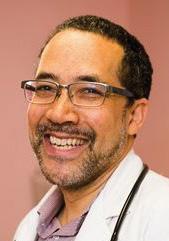
We doctors know how to focus on danger. For three years, the Covid-19 pandemic has been the focus of our medical effort and energy. Yet as we fought the pandemic, the American epidemic of gun violence has been steadily tearing through our communities and flaring up into burst after burst of mass murder. A racist 18-year-old white boy drives across New York with a just purchased assault rifle, searching on the internet for the best place to kill Black people, and devastates a community in Buffalo, New York. A troubled Latino 18-year-old boy legally buys assault weapons and commits a horrific massacre at an elementary school in Uvalde, Texas, devastating a Latino community that fought for educational rights at Robb Elementary a generation before. An angry black man buys an assault weapon, and the same day kills his doctor, our friend Dr. Preston, and three others in the office, apparently because he was not happy with his surgery. And in June a group of young black men in Philadelphia got into a fight outside of a bar in South Philly, pulled out guns instead of fists, and, while trying to kill each other, killed three people and injured 11. One of my teenage patients was enjoying an outing on South Street and had to endure the trauma of seeing one of her friends die during that South Street Philadelphia shooting. During the same
weekend 3 were killed, and 11 injured in Charlotte, North Carolina. Same type of chaos, same mayhem. Chaos! Chaos? Evil people? Crazy gunmen? No. These were Americans. American gunmen being Americans. What have we become…perhaps Americans.

We Americans have a gun violence problem.1 America has a lot of guns…more than one for each American; that’s a lot. America also has a lot of criminals who use guns, who can get guns, who can purchase a gun in a few minutes2. America also has the most citizens who have never committed a crime who have caused a firearm death as their first impulse when in conflict or stress.3 America is in fact the most dangerous place on earth to be intentionally killed by another citizen who is not a combatant in a war zone. We are not aware of this fact because our disproportionate loss of citizens from gun violence has been a common cause of preventable death in the United States for almost a generation.
I don’t want to return to the work of reducing gun violence in Philadelphia. I’m not tired of the work, I’m a Black male pediatrician, I love trying to keep our children happy and healthy, and keeping our youth alive is the first task of my job. I’m frustrated by the rising number of gun homicides and injuries in 2022 Philadelphia. In the 1970s, 1980s and 2000s surges in gun violence were controlled and reversed through a combination of community policing, aggressive enforcement of gun laws, expanded programming for youth, and engagement with citizens returning from incarceration. The 2010’s violence reducers had additional tools to help victims of violence, to expand violence interruption, and teach de-escalation, the skill of turning down the heat of anger. These tools looked like a strategy to keep violence down in Philadelphia and across the country. I don’t want to return to this work because Philadelphia is in a different America. Changing a deadly and complex public health epidemic of gun crime and gun violence takes the unified attention of civil society, government, business, academia and medicine, but our United States are anything but united.
continued on next page >
SPRING 2023 | CHESTER COUNTY Medicine 21 www. CHESTERCMS .org
Stopping gun violence in Philadelphia has become almost impossible because Philadelphia is in America. I am not afraid of gun violence. I’m afraid of American media sensationalism and political cowardice. I’m afraid our fractured nation is so full of argument and anger, so full of disagreement and disappointment that we are numb and unwilling to change our culture. The United States of America is not united, we are separated. We are not states, we appear to be tribes ruled by warlords. We are the land of the free, but not brave enough to stop shooting each other over petty disagreement. What are we going to do?
I’ve been a practicing pediatrician in Philadelphia for more than 25 years. I’ve worked to reduce gun violence in Philadelphia since 1998, as a faculty member, a board member, a deacon, a scout mentor, a counselor, a gardener, a teacher, a father, and a Black man. I’ve worked with the mothers, the survivors, the widows, the shattered parents, the traumatized, the peacekeepers, the violence interrupters, the BlackLivesMatter, the ThinBlueLiners, the politicians, the preachers, the reporters, the elders, and the kids. None of it is enough. Here is why. The good people are working one by one, but the forces of evil have more tools to cause chaos. It is not enough for us to try to do good. We must work together as one toward one goal. To teach the tools of peace and regulate the tools of violence.
Violence spreads like fire. It starts with anger, it is fed by selfishness and impulsiveness, but it is multiplied by guns and the industries that are enriched by violence: weapons, politics, and media.
Peace is spread like water. It starts with patience, it is fed by selflessness and generosity, and it is multiplied by forgiveness, and the industries that are enriched by peace: reconstruction, restoration, and healing.
So how do we restart the work? We must control the violence by controlling the guns. We must challenge the media that teaches boys how to become gunmen. We must challenge our neighborhoods that tolerate and shield impulsive violent neighbors. Boys must not be able to buy military assault weapons before they can drink or gamble, and guns should only be allowed to be bought with a cool head and visible sale. We must fight for universal background checks

22 CHESTER COUNTY Medicine | SPRING 2023 www. CHESTERCMS .org
Philadelphia is ready to overcome gun violence, our great American epidemic continued from page 21
Peace is spread like water. It starts with patience, it is fed by selflessness and generosity, and it is multiplied by forgiveness, and the industries that are enriched by peace: reconstruction, restoration, and healing.
and waiting periods and safe weapons training for new owners. Neighbors and friends need to be able to speak up and help stop hurt people from hurting people. We must fight for red flag laws and community policing boards. Social media must be regulated like any other broadcaster to prevent massacre broadcasting, hate group promotion and violence profit making. These changes will need changes in laws, but also need the engagement of neighbors with their police precincts, of voters with their politicians, and viewers with their media. Americans will need to return to a balance where we value discipline and community more than individualism and carelessness. We can only be free together.
The tools of peace are everywhere but are no longer valued or used. Violence Interrupters focus on teaching patience and tolerance. Victim Support focuses on not only justice but compassion for the injured and traumatized. Healing Hurt People teaches empathy to break the cycle of violence, recognizing that the victims of violence can become perpetrators of more violence. Community policing teaches police to be more communal and the community to police their own community. Restorative justice focuses the justice system on the responsibility of the lawbreaker and society to fix what was broken by the crime, rather than simply punishing. Criminal Justice does not fix society. Guns do not protect society. We must recognize that peace requires much more conversation, more personal responsibility, and more public involvement to take back our streets with Love. Ask Stevie Wonder, Love’s in need of Love today.
1 Small Arms Survey 2018 Estimates 390 million handguns in circu- lation in the US.
2 Estimate 100,000 prohibited felons US continue to own a firearm. https://injuryprevention.bmj.com/content/27/2/145
3 US per capita rates of firearm death from suicide, unintentional deaths, child involvement in shootings, justifiable homicides, firearm deaths from legal intervention (law enforcement), and many mass shootings represent firearm deaths by citizens who have not been or will not be convicted of a prior crime.
Providing Intensive Outpatient Services for those 13+ with a mental health or substance use disorder, specialty services for First Responders, Gambling, Men’s & Women’s Trauma and LGBTQ+

Philadelphia | West Chester Plymouth Meeting | Collegeville Broomall | Jenkintown Wyomissing | Telehealth

267.669.0300 or info@ethostreatment.com

www. CHESTERCMS .org SPRING 2023 | CHESTER COUNTY Medicine 23
GLP-1 Agonists: Something So Good for Patients Just Shouldn’t Be So Hard to Get
BY CHRISTINE MEYER, M.D.
Ihave made it a personal mission to get people suffering from obesity on GLP-1 Agonists for the past year. These drugs are all in the same class, have identical mechanisms, and three are the same generics (Ozempic, Wegovy, and Rybelsus are ALL semaglutide).
They are advertised as Wegovy, Ozempic, Rybelsus, Saxenda, Trulicity, and Mounjaro.
To say these are life savers is NOT an exaggeration. In my mini-experiment of about 60 patients on these medications, THOUSANDS of pounds have been lost. My patients on these medicines have struggled for life and have finally seen their strenuous efforts lead to results. They are fitter, happier, and more confident. Most importantly, they are HEALTHIER. Their blood pressures, cholesterol panels, and arthritis symptoms are better. Their fasting blood sugars are lower. Their risk of cardiovascular disease is lower.
It is bad enough that access to these medications has been difficult, with out-of-pocket costs approaching $1600 per month and supply chain delays. Now, some insurers, despite covering these medications, are labeling ALL patients on these drugs as DIABETICS. Since several of these medications are FDA approved for diabetes but not for weight loss, insurers have decided that IF a patient fills a script for a GLP-1 agonist, they, by
definition, MUST have diabetes and need to be treated as such.
So what is the problem?
First, doctors have been prescribing off-label medications for years. It is crazy to have unequivocal data about the benefits of a drug and hold off on prescribing it while the gigantic, rusty wheels of the FDA turn. We are STILL waiting for new labeling indications on some drugs after decades of using them off-label.
We will NEVER tell an insurer that a patient has diabetes to get these medications covered because that is …um …FRAUD. So, we write the scripts. We use the diagnoses of obesity, morbid obesity, and obesity with complications. Months or weeks later, these same patients appear on our rosters of “diabetic patients needing care.”

The insurers want ALL of these patients to have a diabetic eye exam, blood test, and kidney screen. The problem is – you guessed it – THEY. ARE. NOT. DIABETIC.
The labeling of these patients as diabetics has many implications. First, no patient without a disease – especially a chronic one like diabetes – should be labeled as having it in their medical record. It can follow them in their quest for life insurance, certain jobs, licenses, etc.
For us, because a significant portion of our “diabetic patient
24 CHESTER COUNTY Medicine | SPRING 2023 www. CHESTERCMS .org
population” has not had the appropriate diabetic screenings (see above), WE appear not to take good care of our diabetic patients. As a result, our quality scores go down, and with them, our incentive payments.
For example, in one of our programs, 36 of our 200 or so “diabetic patients” do not have diabetes. That is a BIG number (just under 20% – I used a calculator).
So here is the kicker; for our practice to achieve the highest ratings, we need to either do these tests on all of these patients, whether or not they have diabetes, OR we need to convince the insurance companies to take them off our diabetes lists.
This is where my concussions have come in. The latter is not happening. So then, do we give in and do a couple of blood tests and an eye exam on patients that don’t need them? Our patients say – go for it! They don’t care. They are so so happy to be where they are.
But… guess what? Those same insurers will not cover those tests unless WE add the diagnosis of diabetes to the orders. Of course, we won’t do that because that is…um…fraud.
So, for those patients who happen to be covered by these specific plans, we are stuck.
I come to you all with this because I am a tiny fish in a massive pond. I am told by many people in the insurance industry, from representatives up to medical directors, that the system is unchangeable due to the complexity of the algorithms used but “they are working on it.”
But, maybe if consumers/patients covered by these plans reach out, this may change a little faster.
I know one thing for sure. GLP-1 medication use for obesity is here to stay. The meds will improve, as will the patients’ demand for them. Not only do patients on them NOT have diabetes, they most likely now WILL NOT develop diabetes because they will no longer be obese.
I will keep beating my drum. We have long conversations with patients who may be impacted by this policy and explain the pros and cons. NOT one patient has said, “No thanks. I don’t want to be labeled as a diabetic.” All would opt for the opportunity to change their lives despite this insane hiccup.
Sadly, our stellar scores in the diabetic care arena will go down. But….if that is the price to pay for doing the right thing by our patients, so be it.
To my colleagues prescribing GLP-1 Agonists for weight loss: If your patient is labeled as “diabetic” because of these meds, call, write a letter, and let your voice be heard. Don’t sit back and allow them to be bullied into a diagnosis they don’t have because of a “difficult algorithm.” The ultimate irony is that this is the VERY diagnosis we are trying to prevent!
Obesity is not the consequence of bad behaviors; it is a disease that finally has effective, safe, lasting treatments. Patients with obesity have been marginalized long enough. We, especially healthcare providers, have got to start taking down barriers for these patients – not adding to them.
Grow Your Business in Berks!
Reach 75% of All Berks County Adults… Advertise in Berks 1st Magazine
Berks County’s Official Government Services Magazine

Mailed by the County, Berks 1st is mailed directly to 87,646 residential addresses (60% to 70% of every household in Berks), to 500 business and community leaders, and into another 300 high-traffic locations.
Spanish and English language digital versions are also available on the County’s website.
SPRING 2023 | CHESTER COUNTY Medicine 25 www. CHESTERCMS .org
For Advertising, Contact Tracy@Hoffpubs.com Reserve your space in the Summer/Fall 2023 issue by June 30, 2023.
Politics & Medicine
The Domino Effect of Physician Advocacy
 BY LARRY L. LIGHT RETIRED PAMED LOBBYIST
BY LARRY L. LIGHT RETIRED PAMED LOBBYIST

The domino effect of physician advocacy is somewhat nuanced. Certainly there are exceptions, for example tort reform, but in many cases the end goal of physician advocacy is to protect the clinical ability to treat patients and improve health outcomes. Holding an unrestricted license to practice medicine, physicians don’t need to advocate for an expansion of their scope of practice. Filling their waiting rooms with more patients isn’t often the priority, especially in times of well publicized physician shortages. As a result, the goals of advocacy campaigns to reform insurers’ prior authorization restrictions, reduce the cost of prescription drugs, promote the availability of telemedicine services, ban smoking in public places and a host of other policy initiatives are far more altruistic.
Particularly in health care the “domino effect” can be surprisingly impactful. An example from health care, although not related directly to physicians, would be American Association of Retired Persons (AARP) advocacy for the $35 cap on insulin prices for Medicare patients. The AARP victory resulted in a projected savings of $25 billion in out-of-pocket costs for seniors. In addition, a result of the 2022 prescription drug law and subsequent positive actions taken by drug companies, is that savings will be extended to the much broader community of patients through reduced drug prices. There will also be savings for taxpayers and hospitals as the lower insulin costs and broader reduction in prescription drug costs lead to improved health care for patients. The out-of-pocket dollar savings are dramatic but the domino effect savings are just as real. Also quickly evident will be the positive changes for physicians who are clinically helping patients to manage their care as the domino effect takes hold. AARP engaged in advocacy to achieve an important win for their members and along with
other advocates accomplished much more.
The real challenge of physician advocacy is how to do it successfully, and that challenge is significant. In many cases negative consequences are self-inflicted. Physicians can be especially prone to advocate with an approach of telling policy makers what actions and changes must be undertaken. At all levels of the political universe, especially in situations with strongly divergent partisan forces, demands for change that might seem obvious to the advocate are really not politically practical. The politicians have to consider a broad spectrum of factors, including funding concerns, how the change will be interpreted and implemented and how the action might affect other interests. The aggressive advocate is often just focused on what must, in their eyes, be accomplished to solve their problem.
Another factor that makes physician advocacy challenging is the broad scope of issues that can clutter the advocates’ agenda. Clinical issues should always be a priority, but sometimes those can be pushed aside by a concentration on social issues that while appropriate have the effect of diluting the advocacy message. And from the clinical perspective, different messages and demands from the crowded field of medical specialties can make it difficult for policy makers to prioritize the viable issues. In those instances the dilution of physician advocacy messaging often leads to the relevant issues being set aside for further study.
A very important factor is that physician advocates cannot participate in health care policy discussions without bumping into the very aggressive and well funded advocacy campaigns of other stakeholders. For starters there is no requirement that the wide array of health care providers will have any level of unanimity on any and all issues. All sorts of factors come into
26 CHESTER COUNTY Medicine | SPRING 2023 www. CHESTERCMS .org
play, including how an allied health profession may or may not be impacted by the issue and even how they want to strategically engage relative to a possible scope of practice confrontation with the physician community.

But in health care policy discussion, physicians and other providers are just some of the relevant stakeholders. Policy makers can expect to hear from disease-specific interest groups, the AARP and a wide range of groups created primarily for focused but high profile advocacy activities. In addition, trial lawyers, hospitals and health systems, health insurers, nursing homes, pharmaceutical companies and a whole host of other special interests crowd into health care policy debates. Their advocacy campaigns are always well funded and always aggressive. And many competing advocates have what might seem a minor advantage in that they don’t have to juggle their advocacy work with patient appointments. Hospital leaders are paid to engage on behalf of their employer.
From a more positive perspective, within the very wide and fairly crowded spectrum of health care advocacy there is a special respect among policy makers for the potential that can be reached by physician advocates. Whether it is encouraging support for a political candidate on election day or supporting passage or defeat of legislation, physician advocacy has several positive predictors of success.
Physician advocates begin their engagement on an issue with some built in advantages. It’s a given that they are well educated, both generally and especially with respect to their profession. Sometimes a reminder is necessary, but it is accepted that their education and training outpaces any other health care provider. In many situations, physicians and physician advocacy
organizations then find strong allies among other provider groups.
Successful physician advocacy highlights the sanctity and intensity of the patient-physician relationship and then promotes it as an unbreakable bond. Contemporary health care provider organizations and lobbyists have learned to follow the same tact in regard to policy issues. The patientcentric focus serves as a foundation for not only physician advocacy, but across the health care policy spectrum for the strong allies who contribute to health care policy discussion.
Policy makers are particularly responsive to the clinical focus that physicians can insert into policy debates. Many of the health care issues on the policy docket present the opportunity for consideration of a clinical aspect. The obvious advantage is that this is foreign territory for most legislators and reporters. While they can certainly obtain relevant information online or from other health care providers, the physician advocate perspective gains credibility. Like every episode of the hit television series MASH, relating the issue to a clinical procedure or diagnosis serves to enhance the policy discussion.
It is a given that physician advocates always have tremendous potential to have a significant impact in any health care policy discussion. You won’t win every vote, pass every bill or even get every amendment adopted. But everyone in the discussion will realize the importance of your engagement in the political process.
SPRING 2023 | CHESTER COUNTY Medicine 27 www. CHESTERCMS .org
Larry Light is a retired lobbyist and senior executive of the Pennsylvania Medical Society.
Convergence of Two Commonwealth Court Rulings
BY MYRA FORREST, PHD
Two different but especially important court rulings were presented within the past month in Pennsylvania. One ruling was from Commonwealth Court Judge Renee Cohn Jubelirer finding that the educational funding system in Pennsylvania violates the state constitution education clause as well as the equal protection right of students in financially impoverished school districts. This causes great discrepancies between needy and wealthy districts. The bulk of school funding in Pennsylvania comes from local property taxes. If you live in a wealthy community, the value of the homes and businesses are higher, providing more property taxes to fund the schools. If you live in a poor community, the value of the homes and businesses are lower, providing less money for the schools. Judge Jubelirer’s ruling is 786 pages long and goes into depth as to why the funding system of Pennsylvania public schools is extremely unjust. This case filed in 2014 but did not go to trial until November 12, 2021.
The other ruling from Commonwealth Court was issued by a seven-judge panel and authorized by Commonwealth Court Judge Christine Fizzano Cannon and was against four nonprofit Tower Health Hospitals: Phoenixville Hospital in Chester County, Brandywine Hospital in Chester County (which closed last year), Jennersville Hospital in Chester County (which was sold to ChristianaCare last year), and Pottstown Hospital in Montgomery County. These hospitals were sued by Phoenixville School District, Avon Grove School District, Coatesville School District, and Pottstown School District. Each district filed its own lawsuit against Tower Health. This case has been in litigation since 2021. The districts were suing over the loss of property taxes when for-profit Community Health Systems in Tennessee, which had paid taxes to all four of these districts, sold the hospitals in 2017 to Tower Health, a newly formed nonprofit healthcare system. Tower Health stopped paying property taxes because of its nonprofit status. This ruling stated
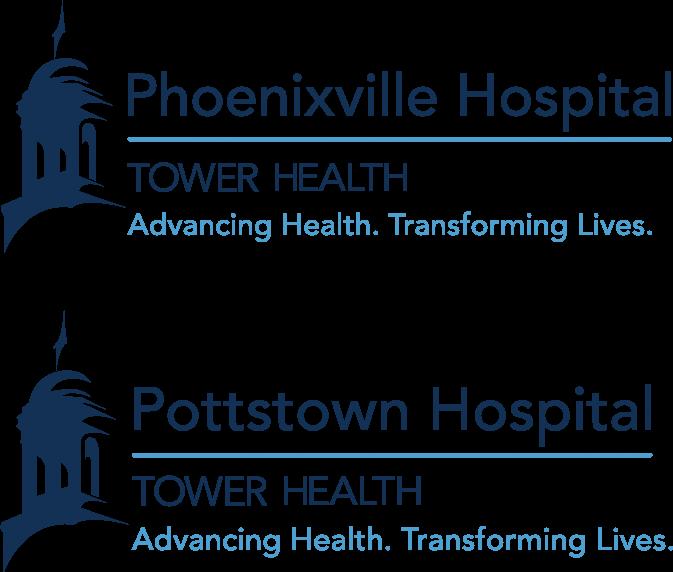

28 CHESTER COUNTY Medicine | SPRING 2023 www. CHESTERCMS .org
these hospitals are not eligible for property tax exemptions and must pay taxes even though they are IRS recognized nonprofit hospitals.
This ruling could have a major impact on all Pennsylvania’s nonprofit hospitals and could actually sweep across the entire nation if the ruling stands after an appeal, should one be made. Our hospitals lose millions of dollars each year by caring for those who are unable to pay. Chester County needs its hospitals to provide essential services for the community and surrounding townships and region. Nonprofit hospitals also offer hundreds of free programs and opportunities for the community.
These two legal cases are vastly different and involve different plaintiffs and defendants but have much in common. They both involve the clear fact that Pennsylvania school districts are not properly funded by the government of the state of Pennsylvania, which relies very heavily on local property taxes from both homeowners and businesses to fund schools. Pennsylvania ranks near the bottom of all 50 states in its funding of public education. School districts are desperate to find additional monies to educate their students from any available source, and these hospitals seem like the perfect answer to an exceedingly small portion of their financial woes.
I am in an incredibly unique position. I have been a publicschool educator serving as a teacher, principal, director of curriculum, assistant superintendent, superintendent, and executive director of an education foundation for four distinctly different school districts over the years. I am also chairperson of the board of trustees at a local nonprofit hospital.
For years, I have spoken on the issue of lack of funding from the state for impoverished school districts and have written editorials on this topic which were published in various county newspapers and online within the past three years. I have joined advocacy groups such as Pennsylvanians for Fair Funding, Power Interfaith, and Draw the Lines, all which support changes in funding for PA’s educational system through numerous and diverse methods. I am a devoted advocate of changing the way schools are funded so that each child has the same educational opportunities as the next child. This should be the case no matter the students’ economic situation, race, sex, athletic, musical, artistic, or intellectual skills, or any other divisive characterization one might find among students.
However, because I have been involved with education and the healthcare systems for most of my career, I can see both sides of this story. I desperately want more money given to low wealth school districts that have been left in the dust by the state and have not had the ability to offer the educational opportunities and offerings of their wealthy counterparts. However, healthcare has taken a huge hit since the beginning of the COVID-19 pandemic, and hospital systems are in dire need of help, having lost countless employees as well as untold millions of dollars over the past few years. Nonprofit systems such as Penn Medicine, Lehigh Valley Health System, Mainline Health, Jefferson Health, and Tower Health have lost a great deal of money during the past few years. These nonprofit hospitals, or hospital systems, are in no shape to pay millions of dollars in taxes. They are already in debt and paying property taxes would put some of them over the edge.
I ask you this question: Would you rather have a local nonprofit hospital to rely upon to take care of your health care, or the taxes they might pay?
You cannot have both right now. If a hospital, already in debt as a nonprofit serving the needs of the community, often without any reimbursement, needs to pay taxes and to do so would put them out of business, would you still want them to pay taxes to the local school district? This might take away the health system you rely upon and the jobs the hospital provides for community members.
If the state government of Pennsylvania does what it should and creates a new system of funding that would lower property taxes and use taxes from other areas other than property taxes to fund education, this problem would go away. Pennsylvania is near the bottom of all states in the United States of America in their system of taxation and funding of education, leaving the bulk of school funding to the local school districts.
Last year the members of the state Senate, House of Representatives and the governor made significant strides in funding underfunded schools, which was a help to these school districts. However, a great deal more must be done to make this a Commonwealth of equal opportunity for all children. Let us hope that our new governor and all our elected representatives do what they have been called to do and change Pennsylvania’s unfair and archaic system of school funding during the upcoming budget season.
SPRING 2023 | CHESTER COUNTY Medicine 29 www. CHESTERCMS .org
National Alcohol Awareness Month
BY TOM CONNELL, LPC, ETHOS CO-FOUNDER
Alcohol has been around forever. Its use is part of the fabric of many in America. It’s been called “The Social Lubricant” or “Liquid Courage” for as long as can be remembered. People use alcohol for many reasons but most agree that alcohol’s effects on the brain – to relax, to sedate, to unwind, or to get “a buzz” – is the primary reason to drink .
Alcohol’s pharmacological effects change with the amount drunk. In small quantities it acts as a stimulant. In larger amounts, alcohol behaves as a sedative. It also impacts our reward system like other addictive substances. When a person drinks, their dopamine levels (one of our feel good neurotransmitters) surge and impact the “pleasure or reward circuit” of the brain. Later, when the drug wears off, levels drop and they feel awful. And this is often what gets folks into trouble with alcohol. Other variables like genetics, environment, and how we cope with stress also play a role in whether or not someone develops a Substance Use Disorder. Either way, alcohol can be a dangerously deceptive substance.
Now imagine the first 18 months of recovery. A person who has experienced alcohol abuse or dependence now faces the challenges of re-entry into a world swimming in booze. Their newly sober brain is constantly exposed to ads on TV or social media; by situations in their living or home environment; by folks they know and/or meet socializing at weddings, BBQs, birthdays. Old memories from past drinking episodes trigger euphoric recall. The stress of new life experiences create the desire to escape or self medicate.
Clients often ask me “How do I cope?” The key is timing and support. I often have them ask themselves: “Am I involved in support groups or therapy, or should I just avoid situations involving alcohol until my brain has healed more?” and “Do I have people I can rely on for help?” Honestly assessing where they are and obtaining feedback from others that they trust becomes crucial. Recovery is an ongoing process. Remember, we don’t have to test ourselves. Wisdom comes from working through these situations and gaining true self worth and confidence in ourselves.

30 CHESTER COUNTY Medicine | SPRING 2023 www. CHESTERCMS .org
In days of yore, when learned men did strive, To heal the sick and keep frail souls alive, A doctor’s heart, with steadfast will did quell The mortal ills that in the flesh did dwell.

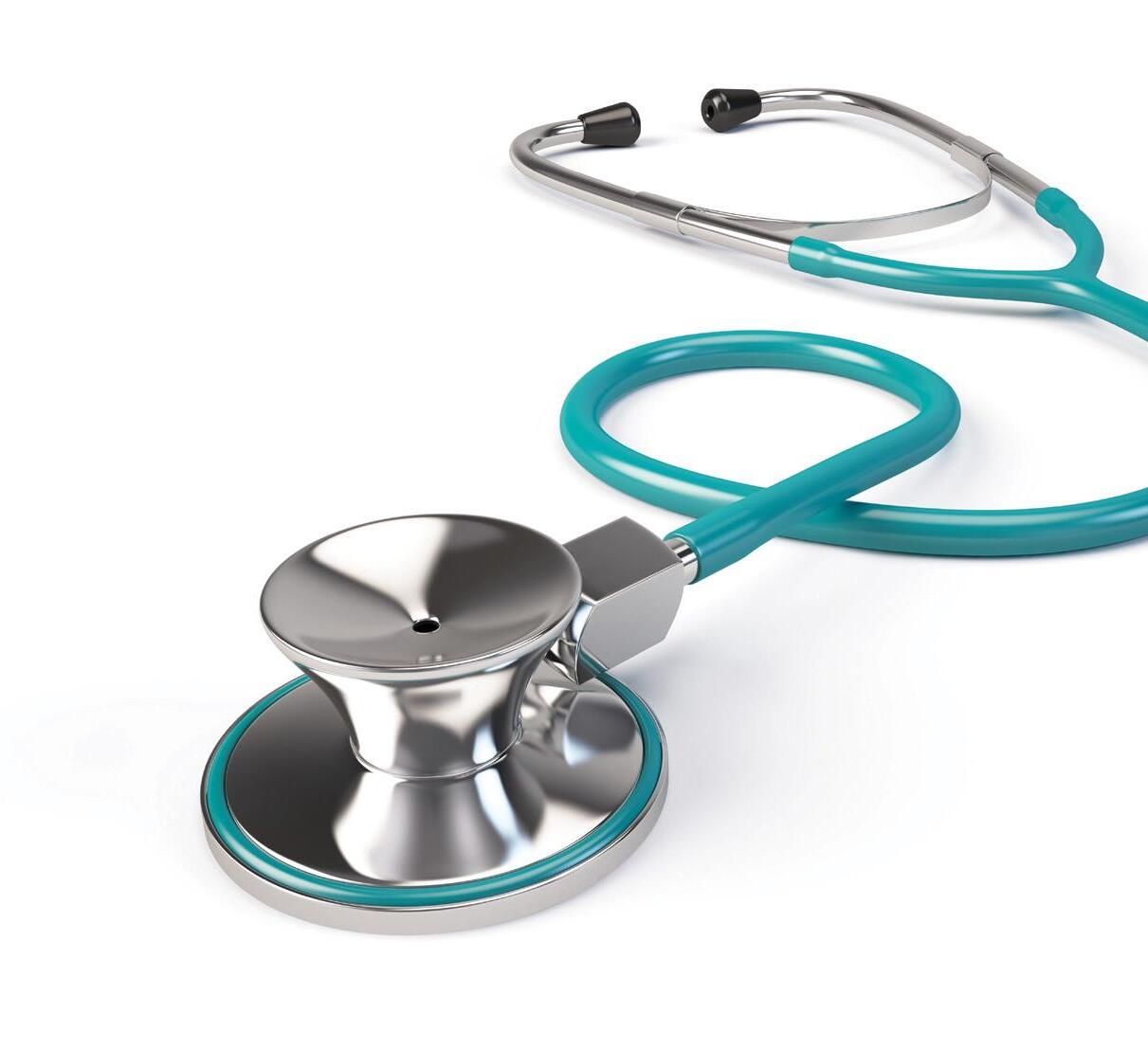

Yet, as the sun doth sink ‘neath heaven’s brow, A hollow weariness, it plagues me now; A burnout deep, that sears my very core, As I, the healer, sick, can heal no more.

With every step, a thousand weights I bear, Of life and death, I toil, yet few do care; In endless nights, my spirit withers fast, The hope that once did gleam, now shadows cast.

O, weary heart, take solace in the night, And find the strength to rise with morning’s light.

Endless work demands, A heavy burden to bear, My soul grows weary. Day after day spent, Healing others, forgetting, My own wounds fester. A shell of myself, Worn thin by this constant grind, Where has joy gone?
Once a noble quest, To heal and make whole again, Now just emptiness. Burnout leaves a scar, A wound that won’t easily heal, I seek renewal.
Reach Your Audience... Reach 35,000+ Engaged Consumers Plus, 3,500+ Physicians, Dentists & Practice Managers Throughout Chester County www.Hoffpubs.com Advertise in YOUR COMMUNITY RESOURCE FOR WHAT’S HAPPENING IN HEALTH CARE CHESTER COUNTY FALL2021 Published by Pennsylvania’s First Medical Society PAGE PAGE YouthPhilanthropy SowGoodNow Developments in Physician Peer Review The Art of Chester County PresentsLELE Galer Reach out to us today! Tracy Hoffmann 610-685-0914 x201 www. CHESTERCMS .org SPRING 2023 | CHESTER COUNTY Medicine 31
FOUND BY CCMS BOARD MEMBER JOHN MAHER, M.D.
Chat GPT-4 Writes Poetry on the Experience of Physician
Burnout
When it comes to MRI providers, there is a difference.
MRI Group has a long tradition of excellence: Accurate image reading. Collaborative, highly trained physicians. Exceptional patient experience. Affordable rates.
• Images read by local radiologists
• Radiologists available 24 hours a day, year round, to read images and provide consultation
• All MRI Group locations are ACR accredited
• All radiologists are board certified by American Board of Radiology
• Experts in various radiology specialties including cardiovascular, interventional, neuroradiology, vascular, musculoskeletal, and pediatric imaging
• Evening appointments available
MRI scans performed at our Parkesburg location
• Abdomen
• Brain
• Chest
• Extremity
• Joint
• Magnetic Resonance
Angiography (MRA)
• Pelvis
• Spine
Phone: 717-291-1016
Fax: 717-509-8642
MRIGroup.com
Several locations in Lancaster County and Chester County
CHESTER COUNTY LOCATION: 950 S. Octorara Trail, Parkesburg (Intersection of Routes 30 and 10)
We are located at the Penn Medicine Lancaster General Health Parkesburg outpatient facility.






 BY DAVID J. GOLDSTEIN, PHD, FCP* PROFESSOR OF CLINICAL PHARMACOLOGY PHILADELPHIA COLLEGE OF OSTEOPATHIC MEDICINE
BY DAVID J. GOLDSTEIN, PHD, FCP* PROFESSOR OF CLINICAL PHARMACOLOGY PHILADELPHIA COLLEGE OF OSTEOPATHIC MEDICINE











































 BY LARRY L. LIGHT RETIRED PAMED LOBBYIST
BY LARRY L. LIGHT RETIRED PAMED LOBBYIST










